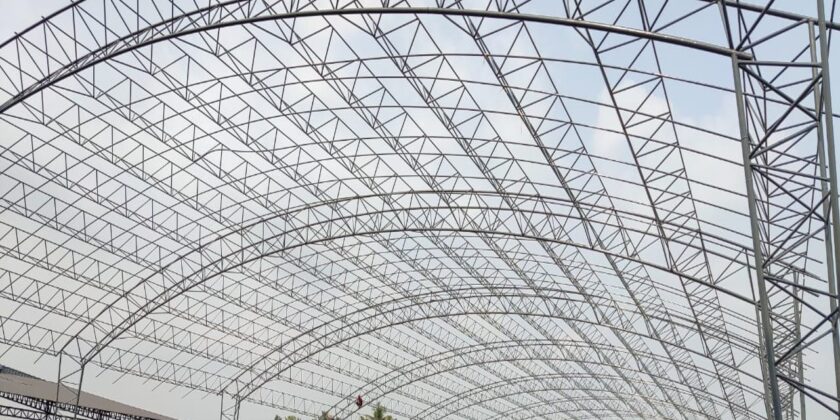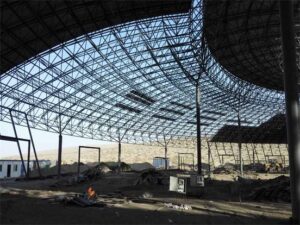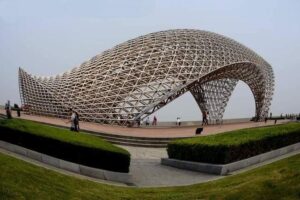Space Frame Structures
Space frame structures are three-dimensional frameworks composed of interconnected struts and nodes. These structures distribute loads evenly across the framework, providing exceptional strength and stability. The concept of space frames dates back to the early 20th century, with significant contributions from engineers like Alexander Graham Bell and Buckminster Fuller.
Advantages of Space Frame Structure
- Strength and Stability: One of the primary benefits of space frame structure is their ability to withstand heavy loads and resist deformation. This is achieved through the even distribution of forces across the entire structure, ensuring maximum strength and stability.
- Lightweight Construction: Despite their robust nature, space frame structures are remarkably lightweight. This characteristic makes them ideal for applications where reducing the overall weight of the structure is crucial, such as in aerospace and automotive industries.
- Aesthetic Appeal: Space frame structures offer immense flexibility in design, allowing architects to create visually stunning and innovative buildings. The intricate lattice design not only provides strength but also adds a unique aesthetic element to the structure.
Types of Space Frame Structure
- Double Layer Grids: Double layer grids consist of two parallel layers of interconnected nodes and struts. This design provides enhanced rigidity and load-bearing capacity, making it suitable for large-span structures like sports stadiums and exhibition halls.
- Triple Layer Grids: Triple layer grids add an additional layer to the double grid system, further enhancing the structural integrity. This type is often used in applications requiring high load-bearing capacity and resilience against dynamic forces.
- Folded Plate Structures: Folded plate structures utilize flat, rigid plates connected along their edges to form a three-dimensional framework. This design is particularly effective for constructing roofs and other large-span applications.
Materials Used in Space Frame Structure
- Steel: Steel is the most commonly used material in space frame structures due to its high strength, durability, and versatility. It provides excellent load-bearing capacity and can be easily fabricated into various shapes and sizes.
- Aluminum: Aluminum offers a lightweight alternative to steel, making it ideal for applications where reducing the structure’s overall weight is essential. Additionally, aluminum is resistant to corrosion, increasing the longevity of the structure.
- Composite Materials: Composite materials, such as carbon fiber-reinforced polymers, are increasingly being used in space frame structures. These materials offer a combination of high strength, lightweight, and corrosion resistance, making them suitable for advanced engineering applications.
Applications of Space Frame Structure
- Architectural Applications: Space frame structures are widely used in architectural applications due to their ability to create large, open spaces without internal supports. They are commonly used in constructing roofs, canopies, and atriums.
- Industrial Applications: In the industrial sector, space frame structures are used to build warehouses, factories, and storage facilities. Their ability to support heavy loads and withstand harsh environmental conditions makes them ideal for such applications.
- Commercial Applications: Space frame structures are also popular in commercial buildings, such as shopping malls, airports, and convention centres. Their aesthetic appeal and structural efficiency make them a preferred choice for large, public spaces.
Design Considerations
- Load Distribution: Proper load distribution is critical in the design of space frame structure. Engineers must ensure that loads are evenly distributed across the framework to prevent structural failure.
- Node Connections: The connections between nodes and struts are vital to the integrity of space frame structures. These connections must be designed to withstand the forces acting on them without compromising the overall stability of the structure.
- Span Lengths: The span length of a space frame structure determines its load-bearing capacity and overall stability. Engineers must carefully calculate the optimal span length to ensure the structure’s safety and performance.
Challenges in Space Frame Structure
- Complexity in Design: The design of space frame structures can be complex, requiring advanced engineering knowledge and software tools. Ensuring the accuracy and precision of the design is critical to the structure’s performance.
- Cost Factors: Space frame structure can be expensive to design and construct due to the specialized materials and techniques involved. However, their long-term benefits often outweigh the initial costs.
- Maintenance Issues: Maintaining space frame structures can be challenging, particularly in harsh environmental conditions. Regular inspections and maintenance are necessary to ensure the longevity and safety of the structure.
Conclusion
Space frame structures represent the pinnacle of modern engineering, offering unparalleled strength, flexibility, and aesthetic appeal. Hindustan Alcox Limited has established itself as a leader in this field, delivering innovative and high-quality solutions for a wide range of applications. As technology continues to advance, the future of space frame structures looks promising, with new materials and techniques set to drive further innovation and market growth.




